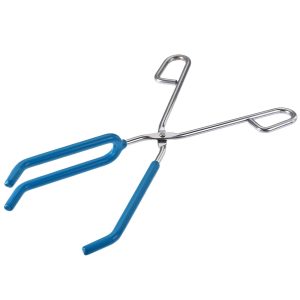Understanding the Versatile Tool Beaker Tongs – Beaker tongs, in the world of laboratory tools, are unsung heroes. These simple tools are essential for a variety of scientific processes and experiments, as they ensure safety and precision see Beaker Tongs.
Understanding the versatility of beaker tongs is important for both seasoned researchers and those starting their scientific journey. This blog will explore the world of beaker-tongs. We’ll look at their types, uses, maintenance, and proper handling.
What is a Beaker Tong?
Beaker tongs, also called glassware tongs, help manipulate and hold beakers. Science experiments commonly use them. Manufacturers usually make them from metal and add a rubber or plastic coating at the tip for a better grip. The tongs are available in different sizes and shapes to fit various types of beakers. They’re a great tool for lab work.
Beaker Tongs: An Important Tool
- Security:The safety of any laboratory is of paramount importance. Beaker tongs are designed to allow scientists to safely handle corrosive or hot substances. They are indispensable because of their heat-resistant material and comfortable grip.
- PrecisionBeaker Tongs provide a firm, steady grip that allows scientists to accurately pour, mix and transfer liquids without spillage. Precision is essential for accurate results.
Types of
This is available in different types, each with a specific application.
- Crucible tongs:This tong has a V-shaped shape to grip crucibles securely. These tongs are used to heat and manipulate crucibles in various chemical processes.
- with a Bent Shape:This tong has a bent shape that provides a more secure grip on beakers. These tongs are perfect for transporting beakers filled with either hot or cold liquids.
- With adjustable jaws: You can adjust the jaws of these tongs to fit different beaker sizes. These tongs are suitable for a variety of laboratory setups.

How to Handle it
Handling beaker tongs correctly is essential for maximizing their effectiveness and ensuring safety in the lab:
- Protective Gear: Wear safety gear including gloves and goggles when handling beaker tongs.
Check for Damage: Inspect the tongs before use for signs of wear or damage. Damaged tongs may not grip well, which can create danger. - Handle Carefully:Use beaker tongs with care. Squeezing the beaker too hard can cause it to break.
- Avoid thermal shock:Take care when moving hot glassware from a warm surface to a cool one or vice versa. Sudden temperature fluctuations can cause glass to break.
Goodbye to Lumpy Protein Shakes with the Blender Bottle
Maintenance
Beaker tongs can last a long time if they are maintained properly.
- Cleaning After Use:Remove any residues from the tongs by using appropriate cleaning agents. This will prevent contamination of future experiments.
- Store CarefullyStore the beaker tongs on a clean, dry surface to avoid corrosion. Hang them up or place them in a cabinet to prevent mishandling.
- Regular Inspect: Periodically check your tongs and replace if needed.
Conclusion
They appear to be a simple instrument and are essential for any laboratory. These tongs are versatile, safe, and offer precision when handling glassware and beakers. Scientists can create a safer and more efficient lab environment by understanding the types of tongs, how they should be handled, and what maintenance is required. This will allow for reliable and accurate experimental results. Remember the importance of beaker tongs the next time that you pick them up.